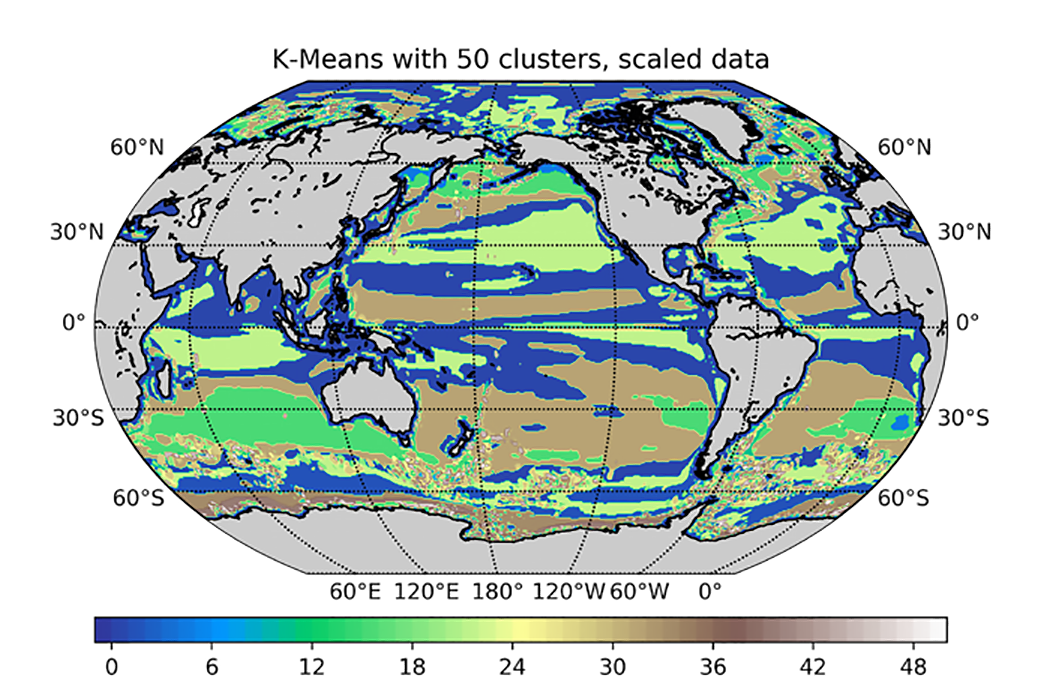
Colors represent the ocean clusters identified in the study. The "depth coherent" ocean region (43%) is dark blue, "interior flow" (24.8%) is light brown, "quasi-Sverdrupian" (14.6%) is light green, "interior flow, vertical" (6.9%) is dark green, "interior flow, Southern Ocean"
(1.9%) is lighter blue, and "dominantly nonlinear torque" covers the remaining 8.9%.

Colors represent the ocean clusters identified in the study. The "depth coherent" ocean region (43%) is dark blue, "interior flow" (24.8%) is light brown, "quasi-Sverdrupian" (14.6%) is light green, "interior flow, vertical" (6.9%) is dark green, "interior flow, Southern Ocean"
(1.9%) is lighter blue, and "dominantly nonlinear torque" covers the remaining 8.9%.
[13-Mar-2019] Unraveling the complexity of our ocean is a daunting task but can be made easier with machine learning techniques that reveal connections in data. Using "K-means clustering" algorithm to identify robust patterns in data, researchers have determined that the dominant physics of the vertically integrated (i.e., top-to-bottom or "barotropic") circulation for about 93% of the global ocean can be categorized into five clusters.
This complicated task began by applying a framework based on the barotropic vorticity (BV) balance - i.e., a compact representation of the depth-integrated momentum equation that exposes characteristic features of rotating fluids – to the ECCO global state estimate. Thanks to 20 years of physical insights inherent in ECCO, its global "BV budget" can be closed. In this study, dominant BV terms were varied to classify and identify unique ocean regions.
The most of dominant physical attribute of the largest regime - representing about 43% of the global ocean - is that wind stress on the ocean surface is balanced by bottom torques. These so-called "depth-coherent" regions span the tropical and subtropical oceans, and comprise large areas in the Arctic (dark blue in figure, below). In 25% of the ocean where the wind stress curl inputs positive vorticity, interior flow is nearly balanced by the beta and bottom terms of the BV equation. These light brown regions are collectively grouped into the "interior flow" cluster. The remaining three clusters identified in study are shown by other colors in the figure.
This study also identified a small percentage of the ocean that did not fall into the five clusters. These dominantly non-linear flow regions are important to the overall ocean circulation and climate, including the Drake Passage, Antarctic-Pacific Ridge, and parts of the Labrador Sea. These areas will be the focus of future studies, including running the same machine learning algorithms at higher resolution and making "deep dives" into the vast amounts of observational data that go into ECCO state estimates.
Read the highlights of a follow-on study,
Elucidating ecological complexity: Unsupervised learning determines global marine eco-provinces (Sonnewald et al., 2020).
References
Sonnewald, M., Wunsch, C., and Heimbach, P. (2019)
Unsupervised Learning Reveals Geography of Global Ocean Dynamical Regions, Earth and Space Science, 6(5), 784-794, doi: 10.1029/2018EA000519.2019-03-13
Click on the image to enlarge. Click on the Escape key or anywhere outside the shadowbox to close.
To download a copy, right click on the image and select Save Image As (on a Mac keyboard, click the touchpad while holding down the Control key). To download the highest resolution in our database, first click on the image to enlarge and then save that version.



